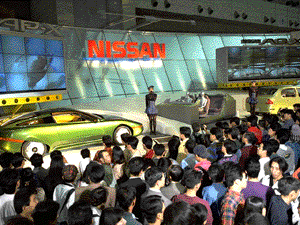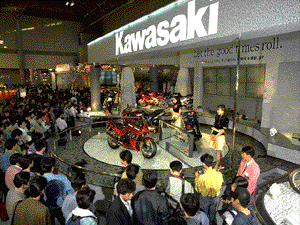 |
 |
 |
The
30th Tokyo Motor Show (1993
. 10/22 - 11/5)
 |
 |
| The 30th Tokyo Motor Show Poster |
"Ecolution in Car Innovation"
The Heisei recession was already in its third year, and
recovery was not yet in sight. During this period, the
auto industry was tackling restructuring to overcome harsh
business conditions such as excessive investment and increased
fixed costs, in addition to sluggish auto sales. Restructuring
included curtailment of expenditures, reduction of the
number of models and parts which had expanded during the
bubble days, sharing of parts among models, value analysis
(VE), and value engineering (VE),etc. As the situation
became more severe, various measures to overcome the recession
were taken. They included complementary production of
models between companies, cutting off deficit-generating
divisions, plant closures, retreat from passenger car
production, employment adjustments such as reduction of
new hiring and lay-offs. In the midst of these endeavors
in 1993, an abrupt appreciation of the yen occurred. The
surge of the yen from around ¥120 to as high as ¥100 all
at once, offset the restructuring efforts, and deteriorated
automakers profitability. In those days, since a rise
of one yen caused an exchange loss of ¥35 billion (according
to MITI calculations), the auto industry s plight was
clear. Meanwhile, 1992 was called "the first year of environment."
As a specific measure, fuel consumption for all models
was required to be improved 8.5% over the the 1990 value
by 2000. The R & D investment burden for environment protection,
therefore, became even heavier, and the auto industry
suffered a structural depression.
|
 |
 |
 |
In 1993, some bright aspects such as the Crown Prince
s marriage and the motor show in autumn were expected
to stimulate consumer demand, and offer an opportunity
for business recovery. However, political instability
(transition from the Liberal Democratic Party to the Hosokawa
Government, and difficulties in political reformation)
plus an unseasonably cool summer ended in failure for
demand creation. Inactivity in other industries further
deteriorated the employment situation. The wholly unemployed
rate in this year was 2.5%, and the number of jobs offered
to those sought dropped to 0.75, from 1.45 during the
bubble days (according to the Office of Management and
Coordination Agency).Consumer confidence cooled to unprecedented
chilly lows. Domestic recession plus weakened international
competitiveness due to the higher yen hit the Japanese
auto industry severely. Its 1993 exports, totalling 5.02
million units, showed negative growth for 8 consecutive
years. Domestic sales of 6.46 million units were down
for 3 consecutive years, and total production of 11.22
million units also shrank for 3 consecutive years for
the first time since World War II. Production was off
17% from the peak bubble days, which drove automakers
into the worst crisis they had ever experienced. As a
result, the industry faced a great turning point, and
was forced to reform even established vehicles. The 30th
Tokyo Motor Show was held amid these abominable circumstances.
However, the motor show dared to make suggestions about
safety, environment, natural resources, energy, and the
relationship between people and vehicles. It was good
to see the industry s strong commitment to motivating
vehicle development for a new era and coping with the
changing times with renewed enthusiasm.
Since this show was held amid a long recession while consumer
confidence was low, it attracted attention from many quarters
including mass media. Attendance came to 1,810,600, 10%
less than the previous show, which was considered a good
showing given the adverse conditions. In fact, there were
still 300,000 more visitors than the 1.52 million who
attended the 16th Show at Harumi at the peak of the Harumi
days. This seemed to indicate enhanced interest in the
shows, based on the spread of vehicular society.
The next-generation concept cars and reference exhibits
at the Motor Show reflected advancements in the Japanese
auto industry. Visits by many top executives, engineers
and designers from overseas suggested that it had become
difficult to precisely forecast vehicle trends or assess
the world auto industry s balance of power without seeing
the Tokyo Motor Show. One of this show s characteristics
was the hightened international position of the Tokyo
Motor Show. In fact, participants included 352 companies,
4 governments and one organization representing 15 countries,
yet another record. The world s major automobile producing
countries joined the show. In addition, 10,794 domestic
and foreign media people gathered at the show on press
days to report the directions in which the changing auto
industry was heading (an increase of 22.2 % over the previous
show). These included 9,025 Japanese (up 25.7 %) and 1,769
foreign (up 7.0 %), both all-time highs. Of note this
year were the many journalists who came from China, Taiwan,
Korea and other Asian countries. This seemed to indicate
that the Tokyo Motor Show, while being vehicle festival,
was also regarded by the world as an information base
to speed the arrival of a new age.
The exhibition of 264 reference cars, one third of the
total exhibits, attracted the world s attention. They
looked gorgeous enough to blow the recession away. Domestic
automakers exhibited 209, of the 264. exceeding the foreign
makers 55. Almost all of the 209 next-generation concept
cars were the products of endeavors to boost safety and
protect the environment. They were much closer to practical
applications, than those at the previous show, a sign
of great progress.
For instance,
models aimed at environmental protection and pollution control
were driven by alternate energies like compressed natural gas
or hydrogen. Electric vehicles (EVs) used high density nickel,
hydrogen batteries rather than lead-based ones. A new trend
was that each maker competed in exhibiting hybrid EVs such as
batteries with hydrogen, gasoline, methanol, or gas-turbine
engines, which showed more advanced environmental protection
technology. Meanwhile, models aimed at resource saving or energy
saving, used lean-burn engines or new generation direct type
engines. Bodies were made of new light, compact materials with
new technology aiding recycling by easy breakdown. Safety-oriented
models were improved from accident-remedy types to more advanced
safety vehicles with accident avoidance apparatus that monitor
drivers misconduct through electronic sensors and computers.
Although it take some more time before completely automatic
operation is possible, partial subordinate apparatus is already
available, and will be gradually adopted in production cars.
These cars were made to meet strict safety and environment standards,
and at the same time made to bring out the performance and comfort
inherently important for cars. The automakers had to work hard
to bring both aspects up to the level of the next generation,
and that required a new stream of R & D. On the other hand,
Mercedes-Benz, BMW and other foreign automakers exhibited small
EVs which were nearly perfected. Volvo displayed a futuristic
EV hybrid with a gas-turbine engine. Those exhibits clearly
showed that the world s automakers were surely heading toward
the development of safe vehicles that would not destroy the
environment.
Although safety and environment were the themes of this show,
the tradition of the motor show is also to offer fantasy and
enjoyment. That is the appeal of a "Festival of Vehicles." The
source of dreams at this show were models awaiting debut in
one or two years, rather than next-generation cars.
These cars included the 3000 GT (Mitsubishi) with its power
sunroof, the 9th generation Skyline GTR (Nissan), the Celica
Convertible (Toyota), and the Ultramini (Daihatsu). The focus
in pleasure cars turned from the hardy RVs that rode wave of
popularity of outdoor leisure to a city-type mini RV exhibit
for reference. Even young women who had not taken interest in
RVs before, were very attracted to the mini RV as a car that
promised fun in the future. Another characteristic was the display
of new models that had just been put on sale. This show was
held just when cars purchased during the bubble days were due
for replacement, so the show seemed to offer an ideal opportunity
for "car shopping." Exhibitors were extremely enthusiastic about
the show after surviving three consecutive bad years. At that
show they exhi-bited brand new cars, 22 fully revamped models,
and 77 partially changed cars to recover sales. These efforts
made the show very lively. Foreign makers too, displayed reference
models soon to be put on sale and 1994 models targeting the
Japanese market. They were also eagerly developing sales. It
was impressive that visitors took strong interest in foreign
makes, which had become less expensive due to the yen s strength.
|
 |
|
|
|